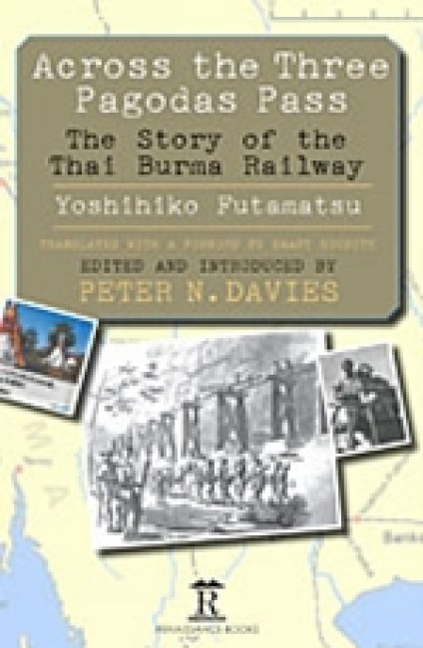Book contents
- Frontmatter
- Dedication
- Contents
- Acknowledgements
- Foreword
- Introduction
- Across the Three Pagodas Pass
- Translator’s Acknowledgements
- Preface
- Chapter 1 Departure for the Front
- Chapter 2 In Indo-China
- Chapter 3 Opening of Hostilities
- Chapter 4 The River Krian
- Chapter 5 The Malayan Campaign
- Chapter 6 The Fall of Singapore
- Chapter 7 Surrender
- Chapter 8 Shōnan: Light of the South
- Chapter 9 The Thai-Burma Railway
- Chapter 10 Preparing Construction
- Chapter 11 Banpong
- Chapter 12 Prisoners-of-War
- Chapter 13 Constructing the Railway
- Chapter 14 Thailand
- Chapter 15 The River Kwae Noi
- Chapter 16 The Mae Khlaung Bridge
- Chapter 17 Kanchanaburi
- Chapter 18 The Jungle
- Chapter 19 From Bangkok to Singapore
- Chapter 20 Rush Construction
- Chapter 21 The Base at Wanyai
- Chapter 22 The Labour Force
- Chapter 23 Survey Unit
- Chapter 24 Test Run
- Chapter 25 Bridge-Building and Shifting Earth
- Chapter 26 The Rainy Season: The Monsoon
- Chapter 27 Kinsaiyok
- Chapter 28 Diseases and Epidemics
- Chapter 29 Cattle Drive
- Chapter 30 Living in the Jungle
- Chapter 31 Soon to the Three Pagodas Pass
- Chapter 32 Towards the Setting Sun
- Chapter 33 Opening to Traffic
- Chapter 34 The Bombing
- Chapter 35 End of the War
- Chapter 36 Internment
- Chapter 37 Repatriation
- Footnote
- Postscript
- End Notes
- Glossary
- Bibliography
- Index
Chapter 17 - Kanchanaburi
Published online by Cambridge University Press: 13 May 2022
- Frontmatter
- Dedication
- Contents
- Acknowledgements
- Foreword
- Introduction
- Across the Three Pagodas Pass
- Translator’s Acknowledgements
- Preface
- Chapter 1 Departure for the Front
- Chapter 2 In Indo-China
- Chapter 3 Opening of Hostilities
- Chapter 4 The River Krian
- Chapter 5 The Malayan Campaign
- Chapter 6 The Fall of Singapore
- Chapter 7 Surrender
- Chapter 8 Shōnan: Light of the South
- Chapter 9 The Thai-Burma Railway
- Chapter 10 Preparing Construction
- Chapter 11 Banpong
- Chapter 12 Prisoners-of-War
- Chapter 13 Constructing the Railway
- Chapter 14 Thailand
- Chapter 15 The River Kwae Noi
- Chapter 16 The Mae Khlaung Bridge
- Chapter 17 Kanchanaburi
- Chapter 18 The Jungle
- Chapter 19 From Bangkok to Singapore
- Chapter 20 Rush Construction
- Chapter 21 The Base at Wanyai
- Chapter 22 The Labour Force
- Chapter 23 Survey Unit
- Chapter 24 Test Run
- Chapter 25 Bridge-Building and Shifting Earth
- Chapter 26 The Rainy Season: The Monsoon
- Chapter 27 Kinsaiyok
- Chapter 28 Diseases and Epidemics
- Chapter 29 Cattle Drive
- Chapter 30 Living in the Jungle
- Chapter 31 Soon to the Three Pagodas Pass
- Chapter 32 Towards the Setting Sun
- Chapter 33 Opening to Traffic
- Chapter 34 The Bombing
- Chapter 35 End of the War
- Chapter 36 Internment
- Chapter 37 Repatriation
- Footnote
- Postscript
- End Notes
- Glossary
- Bibliography
- Index
Summary
The route of the Thai-Burma Railway started from Nong Pladuk, a very small village, ran though the northern suburbs of Banpong, then along the highway to Kanchanaburi, reaching it by way of the villages of Lookgae, Thāruanoi, Thāmoan and others. Kanchanaburi is a town sited alongside the North bank of the river about 50 km upstream from Banpong. Its population was about 3,000. The prefectural office was in a row of houses along the North bank. West of the town the prefectural boundary followed the course of the Mae Khlaung and became mountainous forest. Today it is the key point for tourists at the confluence of the Kwae Yai and the Kwae Noi. In the 1940s it was especially important to the railway construction unit, 9 Railway Regiment, and together with Banpong became the pivotal point in the construction. On Thai-side Sakamoto Unit as advance party came into the town and in early August set up their HQ.
The town was a centre for collecting and distributing commodities and for timber and ores from the mountainous outback: it was also a collecting point for commodities from over the Burma border … including smuggled goods. Because it relied on the Mae Khlaung for the transport of commodities the wharves on the river-front had become the centre of this small town. From antiquity Thailand had been prepared for invasion by the Burmese, and as a form of base defence work there was preserved a stone castle-gate in front of the prefectural office. The town was always called Kamburi for short by both Japanese soldiers and prisoners-of-war, and they called the castle-gate the ‘Gateway to Kamburi’, and it became the point they looked for as a guide-post to the street. There was a paper-factory with bamboo as the raw material: it had a tall chimney. On the highway to Kamburi it made a good sighting-point from a distance.
On the North side of the broad highway in the town is a wide grassy meadow. The railway halt was planned at its northern edge. The quarters of the railway engineers had been built on it.
- Type
- Chapter
- Information
- Across the Three Pagodas PassThe Story of the Thai-Burma Railway, pp. 82 - 85Publisher: Amsterdam University PressPrint publication year: 2013

